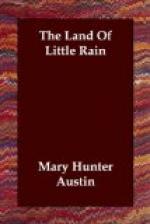It lasted long enough for Seyavi to have evolved the philosophy of life which I have set down at the beginning. She had gone beyond learning to do for her son, and learned to believe it worth while.
In our kind of society, when a woman ceases to alter the fashion of her hair, you guess that she has passed the crisis of her experience. If she goes on crimping and uncrimping with the changing mode, it is safe to suppose she has never come up against anything too big for her. The Indian woman gets nearly the same personal note in the pattern of her baskets. Not that she doe’s not make all kinds, carriers, water-bottles, and cradles,—these are kitchen ware,—but her works of art are all of the same piece. Seyavi made flaring, flat-bottomed bowls, cooking pots really, when cooking was done by dropping hot stones into water-tight food baskets, and for decoration a design in colored bark of the procession of plumed crests of the valley quail. In this pattern she had made cooking pots in the golden spring of her wedding year, when the quail went up two and two to their resting places about the foot of Oppapago. In this fashion she made them when, after pillage, it was possible to reinstate the housewifely crafts. Quail ran then in the Black Rock by hundreds,—so you will still find them in fortunate years,—and in the famine time the women cut their long hair to make snares when the flocks came morning and evening to the springs.
Seyavi made baskets for love and sold them for money, in a generation that preferred iron pots for utility. Every Indian woman is an artist,—sees, feels, creates, but does not philosophize about her processes. Seyavi’s bowls are wonders of technical precision, inside and out, the palm finds no fault with them, but the subtlest appeal is in the sense that warns us of humanness in the way the design spreads into the flare of the bowl. There used to be an Indian woman at Olancha who made bottle-neck trinket baskets in the rattlesnake pattern, and could accommodate the design to the swelling bowl and flat shoulder of the basket without sensible disproportion, and so cleverly that you might own one a year without thinking how it was done; but Seyavi’s baskets had a touch beyond cleverness. The weaver and the warp lived next to the earth and were saturated with the same elements. Twice a year, in the time of white butterflies and again when young quail ran neck and neck in the chaparral, Seyavi cut willows for basketry by the creek where it wound toward the river against the sun and sucking winds. It never quite reached the river except in far-between times of summer flood, but it always tried, and the willows encouraged it as much as they could. You nearly always found them a little farther down than the trickle of eager water. The Paiute fashion of counting time appeals to me more than any other calendar. They have no stamp of heathen gods nor great ones, nor any succession of moons as have red men of the




